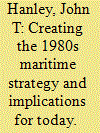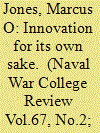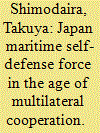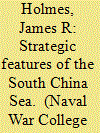|
|
|
Sort Order |
|
|
|
Items / Page
|
|
|
|
|
|
|
| Srl | Item |
| 1 |
ID:
133068


|
|
|
|
|
| Publication |
2014.
|
| Summary/Abstract |
While important differences exist, the first decade of the twenty-first century paralleled the 1970s for the Department of Defense and the U.S. Navy. U.S. armed forces were embroiled in extended and expensive counterinsurgency wars. American military equipment was growing old, budgets were tight, and extended projections called for significant decreases in the nation's armed forces, just as the main prospective military adversary was both rapidly modernizing and expanding its forces, particularly its navy. "From 1962 to 1972, the navy had programmed the construction of 42 ships per year, but between 1968 and 1975 only 12 ships, or less than a third as many per year, were programmed. In 1975, given the age of ships already at sea, and the navy-expected service life for a warship of 25-30 years, the service anticipated retiring about 4 percent of the active fleet each year."1 The Soviets were extending their defensive perimeter from two to three thousand kilometers.2 Today, the Chinese suggest extending their defensive perimeter from the "first island chain," enclosing the East and South China Seas, to the second, bounded by the Marianas, three thousand kilometers from the Chinese coast.3 In the 1970s, the United States questioned its own ability to fight forward, defend allies, and achieve objectives -as many defense analysts and many in the Navy do now.
|
|
|
|
|
|
|
|
|
|
|
|
|
|
|
|
| 2 |
ID:
133071


|
|
|
|
|
| Publication |
2014.
|
| Summary/Abstract |
It has been well over a decade since the first “prophets” of information warfare proclaimed a new age of conflict fought not just on air, sea, and land but with electrons in what came to be known as “cyberspace.”1 Since these early predictions, many incidents have confirmed that criminals, random hackers, and government-sanctioned specialists can wreak havoc on governments, military communications systems, and corporations. The Stuxnet worm alone helped delay-by months, perhaps years-the long-standing efforts of Iran to acquire sufficient nuclear material to build nuclear weapons.2 Recent revelations of hacking campaigns against such publications as the Wall Street Journal and New York Times have broadened concerns to include even the integrity of American democratic institutions.3 Meanwhile, the commander of U.S. Cyber Command has characterized cyber attacks designed to gain access to the intellectual property of American corporations as the “greatest transfer of wealth in human history.”
|
|
|
|
|
|
|
|
|
|
|
|
|
|
|
|
| 3 |
ID:
133073


|
|
|
|
|
| Publication |
2014.
|
| Summary/Abstract |
The origins of this article lie in a new study of the Nazi German economy by Adam Tooze, a fragment of which argues that the need to overcome the technological deficit built by the Western Allies in antisubmarine warfare from 1939 triggered a major shift in U-boat design and production after 1943.1 Tooze points out that an emphasis on technological solutions to strategic and operational problems had by that point become a hallmark of the Nazis', and especially Hitler's, thinking. (Other examples were the Tiger and Panther tanks at Kursk, both of which types proved dysfunctional as platforms, and neither of which proved decisive to the outcome.) So interpreted, the Nazi penchant for imputing to innovation the means to solve a whole class of operational and strategic problems seems to resemble "technological fixes" in other fields of innovation.2 In so arguing Tooze writes off the findings of Richard Overy, who points to the failure of the regime to develop positive relationships between industry and the war effort as reflecting a "peculiar irrationality of the 'Nazi social system.'" Tooze highlights the research of Ralf Schabel on jet-engine development in the aircraft industry, research asserting that exaggerated technological expectations resulted from Germany's hopeless strategic dilemma and that the systems themselves, while quite promising, were rushed into mass production and combat without adequate testing or development. Interestingly, he then characterizes Admiral Karl Dönitz's decision to embrace the Type XXI submarine in 1943, under the technocratic direction of Albert Speer's ministry, as reflecting both the increasing unreality of German armaments propaganda and a progressively more authoritarian cast of the German war economy.
|
|
|
|
|
|
|
|
|
|
|
|
|
|
|
|
| 4 |
ID:
133070


|
|
|
|
|
| Publication |
2014.
|
| Summary/Abstract |
Isaiah Berlin's essay The Hedgehog and the Fox-made famous by the adage "The fox knows many things, but the hedgehog knows one big thing"-explores the pros and cons of a highly focused defense strategy.1 The hedgehog curls up in a ball and defends itself. Hiroshi Doi, former professor at the National Defense Academy of Japan, advocates a "hedgehog-style defense" for Japan, claiming that the country's postwar security policies can still defeat any "sly fox" confronting the nation.2 However, given the emergence of an increasingly complex global security environment, it may be argued that Japan's "defense-only defense policy" is no longer valid. Indeed, must Japan remain a hedgehog forever?
|
|
|
|
|
|
|
|
|
|
|
|
|
|
|
|
| 5 |
ID:
133069


|
|
|
|
|
| Publication |
2014.
|
| Summary/Abstract |
The South China Sea is a semienclosed sea at the intersection between East Asia and the Indian Ocean region. It exhibits characteristics similar to the Mediterranean Sea and the Caribbean Sea, as well as some revealing differences. Both the similarities and the differences commend sea-power theorist Alfred Thayer Mahan's analysis of the Gulf of Mexico and the Caribbean Sea to presentday students and practitioners of maritime strategy. Mahan classified strategic features-especially prospective sites for naval stations-by their positions, strengths, and resources. This article adds a metric to his analytical template, namely, the state of relations with countries that host naval bases. He applied much the same framework to narrow seas, such as international straits, while also sizing up these passages' widths, lengths, and difficulty of transit. Here too an element warrants adding, namely, the underwater terrain-its topography and hydrography.
|
|
|
|
|
|
|
|
|
|
|
|
|
|
|
|
| 6 |
ID:
133072


|
|
|
|
|
| Publication |
2014.
|
| Summary/Abstract |
For the secretary-general of the United Nations, Ban Ki-moon, contemporary piracy is nothing less than a "global menace." There are several piracy "hot spots" the world over, each with its own dynamics, but it is Somali piracy that in recent years has particularly caught the attention and raised the ire of states, shippers, and international organizations. International Maritime Organization (IMO) statistics reflect the quantitative dominance of Somali piracy. In 2010 and 2011, the number of alleged attacks in international waters off East Africa and on the Indian Ocean (into which Somali pirates now venture) was 84 percent of the global totals in each year. In 2012, owing to developments both on land and at sea, the Somali weighting declined, but it was still a considerable 54 percent of global totals.
|
|
|
|
|
|
|
|
|
|
|
|
|
|
|
|
|
|
|
|
|